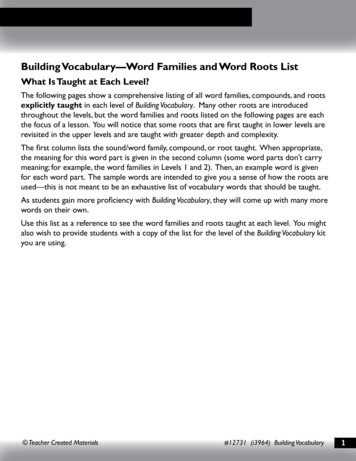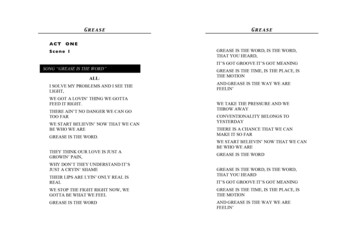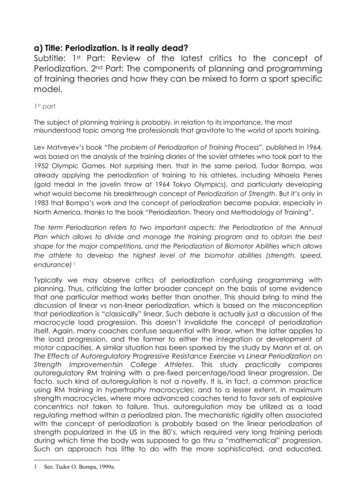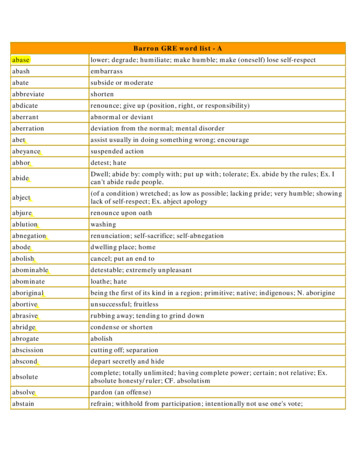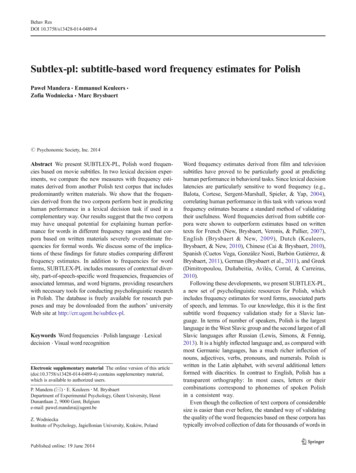
Transcription
Behav ResDOI 10.3758/s13428-014-0489-4Subtlex-pl: subtitle-based word frequency estimates for PolishPaweł Mandera & Emmanuel Keuleers &Zofia Wodniecka & Marc Brysbaert# Psychonomic Society, Inc. 2014Abstract We present SUBTLEX-PL, Polish word frequencies based on movie subtitles. In two lexical decision experiments, we compare the new measures with frequency estimates derived from another Polish text corpus that includespredominantly written materials. We show that the frequencies derived from the two corpora perform best in predictinghuman performance in a lexical decision task if used in acomplementary way. Our results suggest that the two corporamay have unequal potential for explaining human performance for words in different frequency ranges and that corpora based on written materials severely overestimate frequencies for formal words. We discuss some of the implications of these findings for future studies comparing differentfrequency estimates. In addition to frequencies for wordforms, SUBTLEX-PL includes measures of contextual diversity, part-of-speech-specific word frequencies, frequencies ofassociated lemmas, and word bigrams, providing researcherswith necessary tools for conducting psycholinguistic researchin Polish. The database is freely available for research purposes and may be downloaded from the authors’ universityWeb site at http://crr.ugent.be/subtlex-pl.Keywords Word frequencies . Polish language . Lexicaldecision . Visual word recognitionElectronic supplementary material The online version of this article(doi:10.3758/s13428-014-0489-4) contains supplementary material,which is available to authorized users.P. Mandera (*) : E. Keuleers : M. BrysbaertDepartment of Experimental Psychology, Ghent University, HenriDunantlaan 2, 9000 Gent, Belgiume-mail: pawel.mandera@ugent.beZ. WodnieckaInstitute of Psychology, Jagiellonian University, Kraków, PolandWord frequency estimates derived from film and televisionsubtitles have proved to be particularly good at predictinghuman performance in behavioral tasks. Since lexical decisionlatencies are particularly sensitive to word frequency (e.g.,Balota, Cortese, Sergent-Marshall, Spieler, & Yap, 2004),correlating human performance in this task with various wordfrequency estimates became a standard method of validatingtheir usefulness. Word frequencies derived from subtitle corpora were shown to outperform estimates based on writtentexts for French (New, Brysbaert, Veronis, & Pallier, 2007),English (Brysbaert & New, 2009), Dutch (Keuleers,Brysbaert, & New, 2010), Chinese (Cai & Brysbaert, 2010),Spanish (Cuetos Vega, González Nosti, Barbón Gutiérrez, &Brysbaert, 2011), German (Brysbaert et al., 2011), and Greek(Dimitropoulou, Duñabeitia, Avilés, Corral, & Carreiras,2010).Following these developments, we present SUBTLEX-PL,a new set of psycholinguistic resources for Polish, whichincludes frequency estimates for word forms, associated partsof speech, and lemmas. To our knowledge, this it is the firstsubtitle word frequency validation study for a Slavic language. In terms of number of speakers, Polish is the largestlanguage in the West Slavic group and the second largest of allSlavic languages after Russian (Lewis, Simons, & Fennig,2013). It is a highly inflected language and, as compared withmost Germanic languages, has a much richer inflection ofnouns, adjectives, verbs, pronouns, and numerals. Polish iswritten in the Latin alphabet, with several additional lettersformed with diacritics. In contrast to English, Polish has atransparent orthography: In most cases, letters or theircombinations correspond to phonemes of spoken Polishin a consistent way.Even though the collection of text corpora of considerablesize is easier than ever before, the standard way of validatingthe quality of the word frequencies based on these corpora hastypically involved collection of data for thousands of words in
Behav Resstrictly controlled laboratory settings (Balota et al., 2007;Keuleers, Diependaele, & Brysbaert, 2010; Keuleers, Lacey,Rastle, & Brysbaert, 2011). In order to compare frequencyestimates derived from two corpora, it may be more efficientto use words for which the two corpora give diverging estimates, rather than a random set of words. This idea is based onthe observation that the words for which the frequency estimates between two corpora differ most are also the sources ofpotential difference in performance of these frequency normswhen predicting behavioral data. This approach can increasethe statistical power of the experiment; if only randomlysampled words are included in the study, due to very highcorrelation between different frequency estimates, it is moredifficult to detect differences in performance of these estimates without including a very large number of words in theexperiment. Dimitropoulou et al. (2010) approached this problem by using a factorial design in which the critical conditionsincluded words with a high frequency in one corpus and a lowfrequency in the other. In the present study, we will use anapproach based on continuous sampling over the full range ofword frequencies.Although using words for which the two corpora give themost diverging estimates may help to detect differences between their performance in predicting behavioral data, there isa possibility that this approach may bias the experiment infavor of one of the frequency estimates. For instance, words inthe formal register tend to have a much higher frequency inwritten corpora than in spoken corpora. Stimulus selectionbased solely on a criterion of maximum divergence wouldlead to a large selection of words from the formal register,while the formal register may represent just a small part of thecorpus. To account for this possibility, in Experiment 1, weincluded an additional set of words that were randomly sampled from all word types observed in the compared corpora. InExperiment 2, we included only randomly sampled words.Current availability of frequency norms for PolishFor a long time, the only available word frequency norms forPolish were based on a corpus compiled between 1963 and1967 (containing about 500,000 words) and published byKurcz, Lewicki, Sambor, Szafran, and Woroniczak (1990).More recently, several other Polish text corpora have beencompiled, and resources such as concordances and collocations have been made available to researchers. This is the casefor the IPI PAN Corpus of about 250 million words(Przepiórkowski & Instytut Podstaw Informatyki, 2004), theKorpus Języka Polskiego Wydawnictwa Naukowego PWN(n.d.), containing about 100 million words, and the PELCRACorpus of Polish ( 100 million words; http://korpus.ia.uni.lodz.pl/). To our knowledge, none of them provides an easilyaccessible list of word frequencies.The largest of the Polish corpora contains over 1.5 billionwords (National Corpus of Polish [NCP]; Przepiórkowski,2012). It is based mainly on press and magazines ( 830million tokens), material downloaded from the Internet( 600 million tokens), and books ( 100 million tokens). Italso contains a small sample of spoken, conversational Polish( 2 million tokens). In addition to the full corpus, a significanteffort has been invested in creating a subcorpus that is representative of the language exposure of a typical native speakerof Polish. This balanced subcorpus (BS–NCP) contains about250 million words. Spoken materials (conversational andrecorded from media) constitute about 10 % of the subcorpus.The remaining 90 % is based on written texts (mainly fromnewspapers and books).Since the word frequencies derived from the NCP balancedsubcorpus seem to be the most appropriate existing wordfrequencies for psycholinguistic research in Polish, we decided to compare them with the new SUBTLEX-PL frequencies.SUBTLEX-PLCorpus compilation, cleaning, and processingWe processed about 105,000 documents containing film andtelevision subtitles flagged as Polish by the contributors ofhttp://opensubtitles.org. All subtitle-specific text formattingwas removed before further processing.To detect documents containing large portions of text inlanguages other than Polish, we first calculated preliminaryword frequencies on the basis of all documents and thenremoved from the corpus all files in which the 30 mostfrequent types did not cover at least 10 % of a total count oftokens in the file. Using this method, 5,365 files were removedfrom the corpus.Because many documents are available in multiple versions, it was necessary to remove duplicates from the corpus.To do so, we first performed a topic analysis using LatentDirichlet Allocation (Blei, Ng, & Jordan, 2003), assigningeach file to one of 600 clusters. If any pair of files within acluster had an overlap of at least 10 % unique word-trigrams,the file with the highest number of hapax legomena (wordsoccurring only once) was removed from the corpus, sincemore words occurring once would indicate more misspellings.After removing duplicates, 27,767 documents remained,containing about 146 million tokens (individual strings, including punctuation marks, numbers, etc.), out of which 101million tokens (449,300 types) were accepted as correctlyspelled Polish words by the Aspell spell-checker (http://aspell.net/; Polish dictionary available at ftp://ftp.gnu.org/gnu/aspell/dict/pl/) and consisted only of legal Polish,alphabetical characters. All words were converted tolowercase before spell-checking. Because Aspell rejects
Behav Resproper names spelled with lowercase, this number does notinclude proper names.Frequency measuresWord frequencyIn addition to raw frequency counts, it is useful for researchers tohave measures of word frequency that are independent of corpussize. First, we report word frequencies transformed to the Zipfscale1 (van Heuven, Mandera, Keuleers & Brysbaert 2014). TheZipf scale was proposed as a more convenient scale on whichword frequencies may be measured. In order to reflect the natureof the frequency effect, it is a logarithmic scale (like the decibelscale of sound intensity), but, in contrast to the logarithm offrequency per million words, it does not result in negative valuesfor corpora of up to 1 billion words. In order to make interpretation of the frequency values easier, the middle of the scaleseparates low-frequency from high-frequency words, and, for amajority of words, the measure takes a value between 1 to 7,which resembles a Likert scale. Another compelling property ofthe Zipf scale is that it allows assigning a value to words thatwere not observed in a corpus by incorporating Laplacesmoothing, as recommended by Brysbaert and Diependaele(2013); without the transformation, such words pose aproblem, since the logarithm of 0 is undefined, which makes itimpossible to estimate log10 of word frequency per million forthese words. In addition to the raw frequency and the Zipf scalefrequencies, we also provide the more traditional logarithm offrequency per million words.above the level of individual word forms. For each word inSUBTLEX-PL, we also provide the lemma and the dominantpart of speech and their frequencies.Providing the lemma associated with each given word formallows us to group inflected forms of the same word. This maybe useful when investigating the specific contributions ofsurface and lemma frequencies in word processing(Schreuder & Baayen, 1997) or in order to avoid includinginflections of the same word when creating a stimulus set foran experiment.Information about the dominant part of speech allowsresearchers to choose words of a particular grammatical class(e.g., when a researcher wants to include only nouns in astimulus list).To obtain part-of-speech and lemma information for words,we used TaKIPI, a morphosyntactic tagger for Polish (Piasecki,2007) supplied with the morphological analyzer Morfeusz(Woliński, 2006). The resulting tag set was too detailed forour purposes, so we translated the original tags to a simplerform that includes only information about parts of speech anddiscards other details.2 The tagging process assigned each of theword forms consisting of legal Polish alphabetical charactersand accepted by the spell-checker to 1 of 78,361 lemmas.Bigram frequenciesAlthough in this article we focus on unigram frequencies, wealso provide frequency estimates for word bigrams, which areof increasing interest to researchers (Arnon & Snider, 2010;Siyanova-Chanturia, Conklin, & van Heuven, 2011).Contextual diversityAdelman, Brown, and Quesada (2006) proposed that thenumber of contexts in which a word appears may be moreimportant than word frequency itself and that the number ofdocuments in which a word occurs may be a good proxymeasure for the number of contexts (contextual diversity[CD]). According to this view, even words with equalfrequency would be processed faster if they occur in morecontexts. Brysbaert and New (2009) observed that CD accounts for 1 %–3 % more variance than does word frequency.Part-of-speech-specific frequenciesFor languages with a rich inflectional system, such as Polish, itis crucially important to provide researchers with information1zi ¼ log10 ðci þ1n Þ þ 9 (van Heuven, Mandera, Keuleers &ck þnk¼1Brysbaert 2014) Where zi is a Zipf value for word i, ci is its raw frequency,and n is the size of the vocabulary.Experiment 1MethodStimuliWe selected stimuli from the list of words common to bothBS–NCP and SUBTLEX-PL.3 All stimuli considered forselection contained only alphabetical characters and occurredwithout an initial capital in most cases. We used the list of 1grams (available at http://zil.ipipan.waw.pl/NKJPNGrams) togenerate the BS–NCP frequency list used in the present study.We processed the raw list by summing frequencies of all formsthat were identical after removing punctuation marks attachedto some of the forms in the original list.2For mapping between original and simplified tags, see supplementarymaterials.3A nonfinal version of SUBTLEX-PL, based on nearly 50 milliontokens, was used
includes frequency estimates for word forms, associated parts of speech, and lemmas. To our knowledge, this it is the first subtitle word frequency validation study for a Slavic lan-guage. In terms of number of speakers, Polish is the largest ll Slavic languages after Russian (Lewis, Simons, & Fennig,


